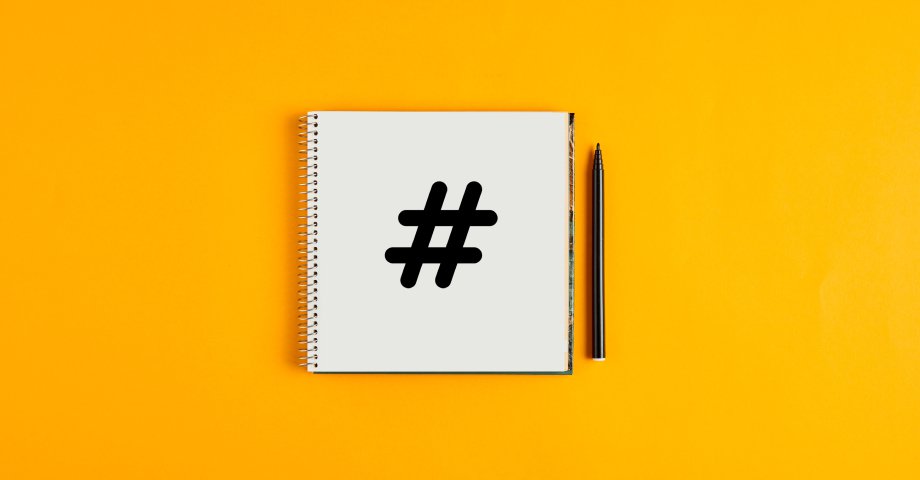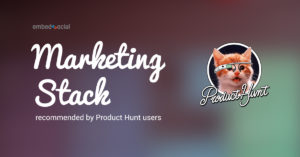If Instagram marketing is one of your customer acquisition channels, you’re probably aware of the importance of Instagram hashtags.
Instagram hashtags are still one of the best ways to attract a relevant Instagram audience to your Instagram posts.
But, if you’re not an Instagram expert, some of the following questions are probably popping up:
- How do I know which hashtags to use for my posts?
- What hashtags are trending right now?
- Should I use them in the comments instead of the caption?
In this guide to using Instagram hashtags, we answer these questions and much more.
FYI: You can automatically embed an Instagram widget with a social media aggregator, bringing your website to life with fresh content.

Display your Instagram feed on your website automatically!
Generate and embed Instagram widget with your feed, mentions, or hashtags directly to your website.
What are Instagram hashtags?
A hashtag is a string of characters, numbers, and/or emojis that begins with the # sign.
They’re used to make social media posts easy to find.
When you click on a hashtag, you get a list of posts marked with it.
People add hashtags of keywords related to the post.
In addition, you can find Instagram hashtags on almost every Instagram post.
Likewise, you can use them to make your Instagram posts discoverable or follow them to find posts related to topics you like.

Also, you can make up your own unique branded hashtags to mark your content.
Furthermore, you can categorize your campaign posts or mark all posts of a particular product you have.
To mark your post with a branded hashtag, you can simply insert it in the post caption.
In addition, the same thing goes for Instagram stories too.
When you start writing the first letters of the hashtag, you’ll see suggestions of related hashtags beginning with those letters.
You can choose some of them or add your own.
Some users put hashtags in their post captions, while others choose to include them in the comments.
Both ways are successful, and there is no firm agreement on which is best.
Just like almost every other thing in marketing, you’ll have to test to figure out what works for your posts.
Why use Instagram hashtags?
Instagram hashtags are a free way to reach a bigger audience with your posts.
When you add a hashtag to your post, your post/story will be featured on the hashtag page.

Also, if you get a lot of engagements, it will stay at the top for a longer period as one of the most popular posts for that hashtag.
Namely, if someone is interested in a topic and follows a hashtag for that topic, they’ll probably see your post being marked with that hashtag.
As the Instagram algorithm shows hashtags-related content according to users’ interests, marking your post with a hashtag makes it more likely for people interested in that topic to discover it.
For example, if you’re organizing an event, you can create a hashtag that connects all event posts.
Participants can follow that hashtag and stay up-to-date with all the information.
In summary, the Instagram hashtags benefits are:
- Spread the word about a specific campaign
- Promote a new product to new audiences
- Get discovered by actual customers
- Increase brand awareness and reach
- Show your support for a movement or trend
- Help people find your content more easily
- Connect with like-minded Instagram users
Types of Instagram hashtags

To better understand the Instagram hashtag, let’s explore the different hashtags we can add to our Instagram posts.
According to Instagram’s blog, there are 9 types of hashtags:
- Product or service hashtags, like #sneakers, or #dress.
- Industry hashtags, like #creativewriting, or #fashiondesigner.
- Community hashtags, like #instaphotography, or #instagramrunners.
- Events or seasonal hashtags, like #christmaseve, or #nationaldogday.
- Location hashtags, like #croatiafulloflife, or #bestofnorway.
- Daily hashtags, like #throwbackthursday, or #sundayvibes.
- Phrases or terms, like #ilovemyjob, or #sisterslove.
- Acronym hashtags, like #ICYMI (in case you missed it), or #ootd (outfit of the day).
- Emoji hashtags, like #sunnyday☀️, or #relax?.
You’ll choose the type or types of hashtags depending on the content you’re posting and the search intention you want to target.
For example, if you have a hotel in your post, you can use a location hashtag, like #miamihotel.
Banned hashtags for Instagram posts

In addition to the hashtag types we mentioned, there are also banned hashtags you shouldn’t use.
Instagram has disabled these hashtags due to spam complaints or violations of its community standards.
Posts using these hashtags will be withheld from the public.
Your post’s reach and engagement will suffer when you use a banned hashtag.
It’s also possible that your Instagram account may be shadowbanned, meaning that new postings will only be visible to your followers.
As a result, it’s critical to avoid banned hashtags wherever possible.
Here is a list of some of the permanently banned hashtags:
- #ILoveMyInstagram
- #Lean
- #WTF
- #Snapchat
- #Shit
- #Nazi
- #Nude
Check out some of the banned Instagram hashtags here.

Display social media wall on your website automatically!
Try EmbedFeed and display Instagram, Facebook, YouTube, Pinterest, TikTok, and Vimeo feeds on your website in seconds.
Tips for using Instagram hashtags
In this part, we’ll share some tips and best practices on using hashtags on Instagram.
Think about your target audience
Keep in mind who you’re aiming to target when adding hashtags.
If you’re just looking for likes, use a more general hashtag that will reach many people, like #sunnyday.
However, if you want to cultivate an audience, you should be more specific and aim for more targeted hashtags related to what you’re posting on your Instagram account.
Moreover, you should stay consistent if you want your target profile to remember you.
If you post #sunnyday one day, #hotelsinhawaii the next, and #kitchen the third, there’s no way the same audience will find all three relevant.
In fact, use hashtags that are related to what you’re posting. More importantly, use hashtags that are relevant to your audience’s interests. For example, if your audience is vegan, and looking for a dessert that is vegan, then the following hashtags will target exactly their search.
This means your post might appear in a top position as it matches the words your vegan audience might use, such as #vegandesserts #desserts #dessertrecipe #vegan #plantbased #vegansofig #hotcakes #veganhotcakes #hotcakerecipe
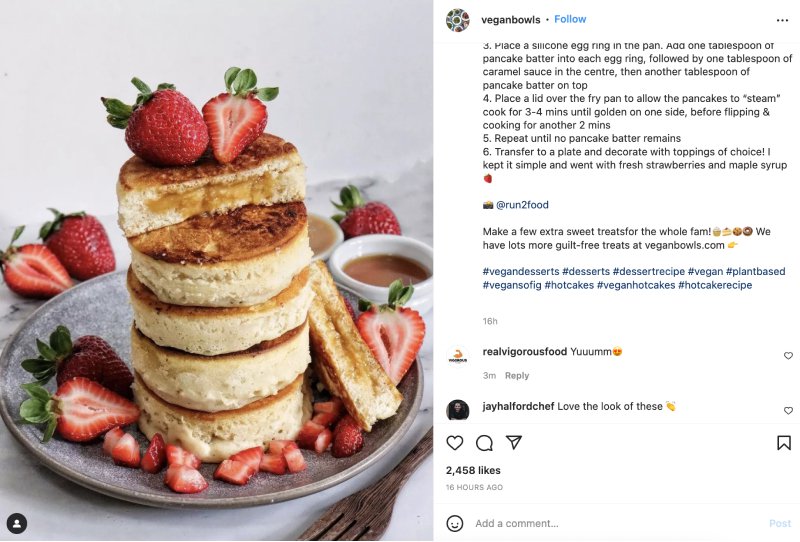
Find the right hashtags
Before using hashtags, you should spend some time finding the right hashtags.
Firstly, find the banned hashtags for your industry and make sure you don’t use them.
Next, find your competitors’ profiles and see what hashtags they use for similar posts.
You can also search for influencers in the industry and see how they use hashtags. Create a table of your hashtag strategy similar to this:

Once you make a list of your relevant hashtags, follow them and regularly check what posts are coming up.
Notice the posts that get the most reactions and engagement.
Also, see what other related hashtags are used in these posts and try to include them in your Instagram marketing strategy.
For better results, use an Instagram hashtag generator tool.
We’ll talk about Instagram hashtag generators a bit later in this article.
Don’t use popular hashtags only

We get that using popular hashtags is very appealing because they have a large following, but it’s actually very difficult to get your post to the top.
Many people think the same and use these hashtags on their posts, so it’s easy to get your post lost among them.
Instead, combine trending hashtags with some more specific ones.
More specific hashtags don’t have many followings, but their followers are probably more educated and familiar with the product and the industry.
Therefore, if you use these kinds of hashtags, you are more likely to get your post noticed by someone dedicated to the topic.
Update your list regularly

Okay, so you did your research and made a list of hashtags you want to use.
But, things don’t end here.
Like any other thing related to marketing and social media, the hashtag landscape is dynamic.
Moreover, new hashtags come up every day.
And that’s why you need to check what’s new regularly and update your list.
You could dedicate a time of the week just for exploring new hashtags and always be on top of the game.
Create your own hashtag
The ideal hashtag for your brand may be the one you create yourself.
Also, you can use it to promote posts about your brand.
Or, you can create one specific to a certain Instagram hashtags campaign you’re running.
For example, Nike uses #nikerunning to promote its products made for runners.
Instagram users have adopted this hashtag, so many of them use it for posts when running in their Nike equipment. Or Moxy Hotels use #atthemoxy to inspire people to share photos when they visit any of their hotels worldwide.

Track how people are using your hashtag. Look for ways to repurpose good material or engage with famous figures of your audience.
Use 3-5 hashtags
Instagram allows you to use up to 30 hashtags in your post.
However, how many hashtags should you use per post?
Last year, there was a rumor that it’s best to use 8-11 hashtags.
Then, a post on the corporate Instagram @creators profile says it’s best to keep the hashtag number between 3 and 5.

However, this can also be a subject of testing.
Add different numbers of hashtags to different posts and see how they perform.
Different rules apply to different types of businesses.
Hide your hashtags for a better visual experience
So, you spent some time crafting the perfect caption, but all the hashtags you want to add won’t look so good next to it.
No worries, you can hide them.
One way to do this is to save the caption as it is and then add your hashtags in the comment section.
Your hashtags will not be seen on mobile except if a user clicks View all comments.
On desktop, though, your comment will remain at the top, thus, this method is more effective if mobile Instagram users are your target.

Another way to hide your hashtags on Instagram is to add several dots in new rows after your caption, so the hashtags will only be visible if people tap the …more button.
This is because only the first three lines of the Instagram caption are visible. Here is an example:
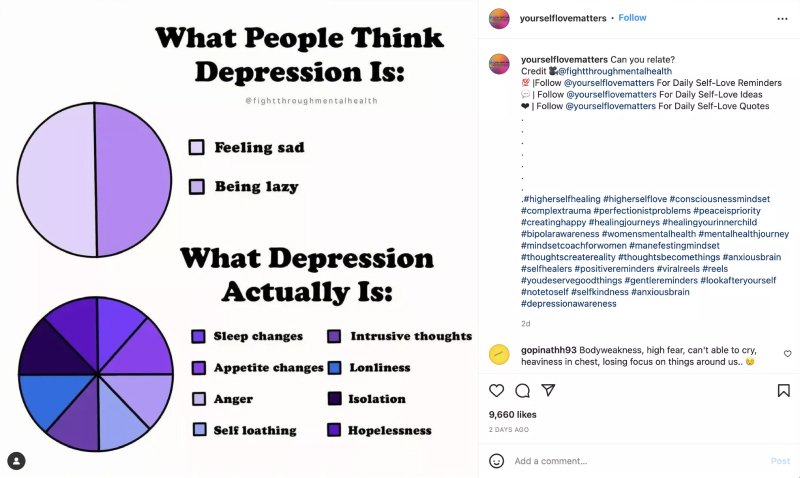
If you want to hide your hashtag on your Instagram stories, you can shrink it to look really small.
However, if you want it completely invisible, use an emoji or a sticker to cover it.
5 simple ways to find trending hashtags on Instagram
Hashtags you add to your Instagram post should be relevant and trending.
Here are some ways to find them:
- Go to the Explore page and see the hashtags on popular posts.
- When you start to type a hashtag, see what suggestions are coming up.
- Use a social listening tool to see what’s trending.
- Follow industry influencers or micro-influencers and see what they’re using.
- Follow competitors and see what hashtags they use on the latest posts.
100 Most Popular Instagra Hashtags
Popular Instagram hashtags by industry
Next, let’s see some of the most popular Instagram hashtags by industry.
Top Instagram hashtags for beauty products

- #skincare
- #makeup
- #hudabeauty
- #kbeauty
- #beautybloggers
- #naturalbeauty
- #cleanbeauty
- #beautyaddict
Find more here.
Top Instagram hashtags for fashion

- #instafashion
- #fashionblogger
- #fashionista
- #fashionstyle
- #fashiondaily
- #fashionmodel
- #vintagefashion
Find more here.
Top Instagram hashtags for travel

- #travel
- #igtravel
- #instatravel
- #travelphotography
- #travelpics
- #travelawesome
- #natgeotravel
- #solotraveler
- #escape
- #beachlife
Top Instagram hashtags for health and wellness

- #workout
- #gethealthy
- #eatclean
- #healthyeating
- #healthyrecipes
- #fitnessgoals
- #fitnessmotivation
Find more here.
Top Instagram hashtags for food

- #yummy
- #foodporn
- #delicious
- #foodie
- #foodblogger
- #foodstagram
- #instachef
- #cooking
Find more here.
Top Instagram hashtags for interior design

- #interiordesire
- #housetour
- #interiorlovers
- #homerenovation
- #interiorstylist
- #homegoals
- #homereno
Find more here.
Top Instagram hashtags for web design
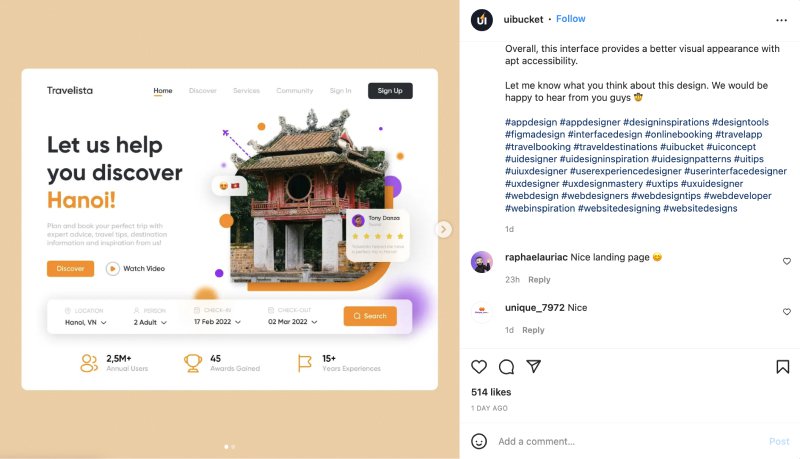
- #websitedesign
- #uxdesigner
- #appdeveloper
- #webdevelopers
- #uiuxdesigner
- #userexperience
- #webdesigners
Find more here.
Top Instagram hashtags for real estate

- #emptynest
- #broker
- #housegoals
- #mansion
- #househunting
- #virtualtour
- #luxurylistings
Find more here.
Top business hashtags
- #financialfreedom
- #businessman
- #businesswoman
- #businessopportunity
- #businesslife
- #homebusiness
- #startupstory
Find more here.
Tools to generate Instagram hashtags
Searching for the right hashtags can be a long and exhaustive process.
Luckily, there are tools that can assist you in your hashtag search and save your time and effort.
Also, you can use them to find the most relevant Instagram hashtags.
After you’ve developed a hashtag strategy, hashtag tools may support you in tracking your postings to see which hashtags are most effective and which aren’t.
Here are some Instagram hashtag tools you could use:
Embed an Instagram hashtag wall on your website
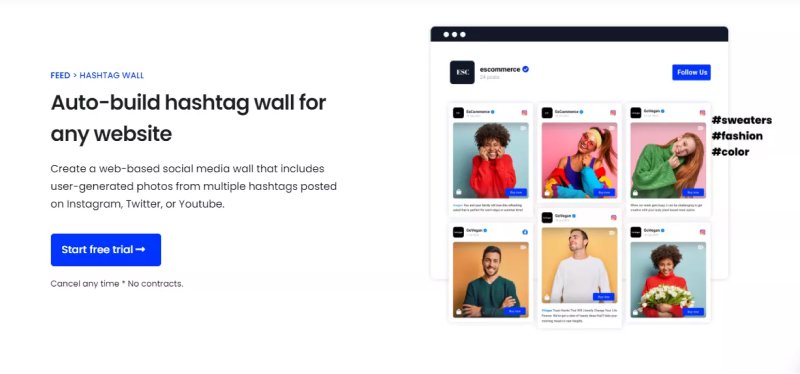
EmbedFeed is a social media aggregator that syncs all of your social media postings with your website automatically.
The software generates and displays photos, posts, and hashtags from all popular social media platforms, including Instagram.
In fact, it is one of the best tools for user-generated content, with the ability to collect and embed an Instagram feed on any website with a single line of code.
With this option, you can easily create a hashtag wall for your website that will automatically update each time there is a new post for that particular hashtag.
Moreover, the process of embedding a hashtag wall is simple and easy.
You just need to:
- Register for an EmbedSocial account
- In sources add Instagram and choose Hashtag as a source type
- Enter the hashtag (s) you want to pull content from
- Next choose the layout of the hashtag widget and create the widget
- Customize the widget look, or moderate the posts in the widget
- Once you finish customizing, copy/paste the provided code on your website

Display social media wall on your website automatically!
Try EmbedFeed and display Instagram, Facebook, YouTube, Pinterest, TikTok, and Vimeo feeds on your website in seconds.
Common FAQs about Instagram hashtags
You can use hashtags in the post caption, comment section, or stories.
You can use a maximum of 30 hashtags, but Instagram recommends using 3-5 hashtags.
Yes, if you put your hashtags in the comments, your post will rank for those hashtags. It’s the same as adding them to your captions.
You can hide them by adding dots after the caption or writing them in the comments, which are immediately visible only on the desktop.
It’s best to combine popular and more niche-oriented hashtags to reach a more specific audience.
No. Instagram detects these accounts, and they get shadowbanned.
In theory, you can. But practice says that this is ineffective.
Key takeaways
Instagram hashtags can be a great tool to boost post engagements and eventually increase sales, especially if Instagram is one of your main marketing channels.
To sum up, here are the most important conclusion:
- Hashtags are keywords that can bring a larger exposure to your Instagram posts.
- You can use them to get a larger and more specific audience genuinely interested in the topic you’re posting about.
- There are different ways to find Instagram hashtags, including following influencers, checking the competition, and analyzing the explore page.
- After you find the right Instagram hashtags, don’t forget to constantly explore to stay up-to-date.
- Check Instagram’s blog and the @creators profile to get informed about Instagram’s recommendations.
- You can use many tools to generate Instagram hashtags relevant to your business.
And, keep testing!
Things that work for others might not work for you, and the other way around.
Your secret weapon might be something you never thought of before.
FYI: You can automatically embed an Instagram widget with a social media aggregator, bringing your website to life with fresh content.

Display your Instagram feed on your website automatically!
Generate and embed Instagram widget with your feed, mentions, or hashtags directly to your website.

